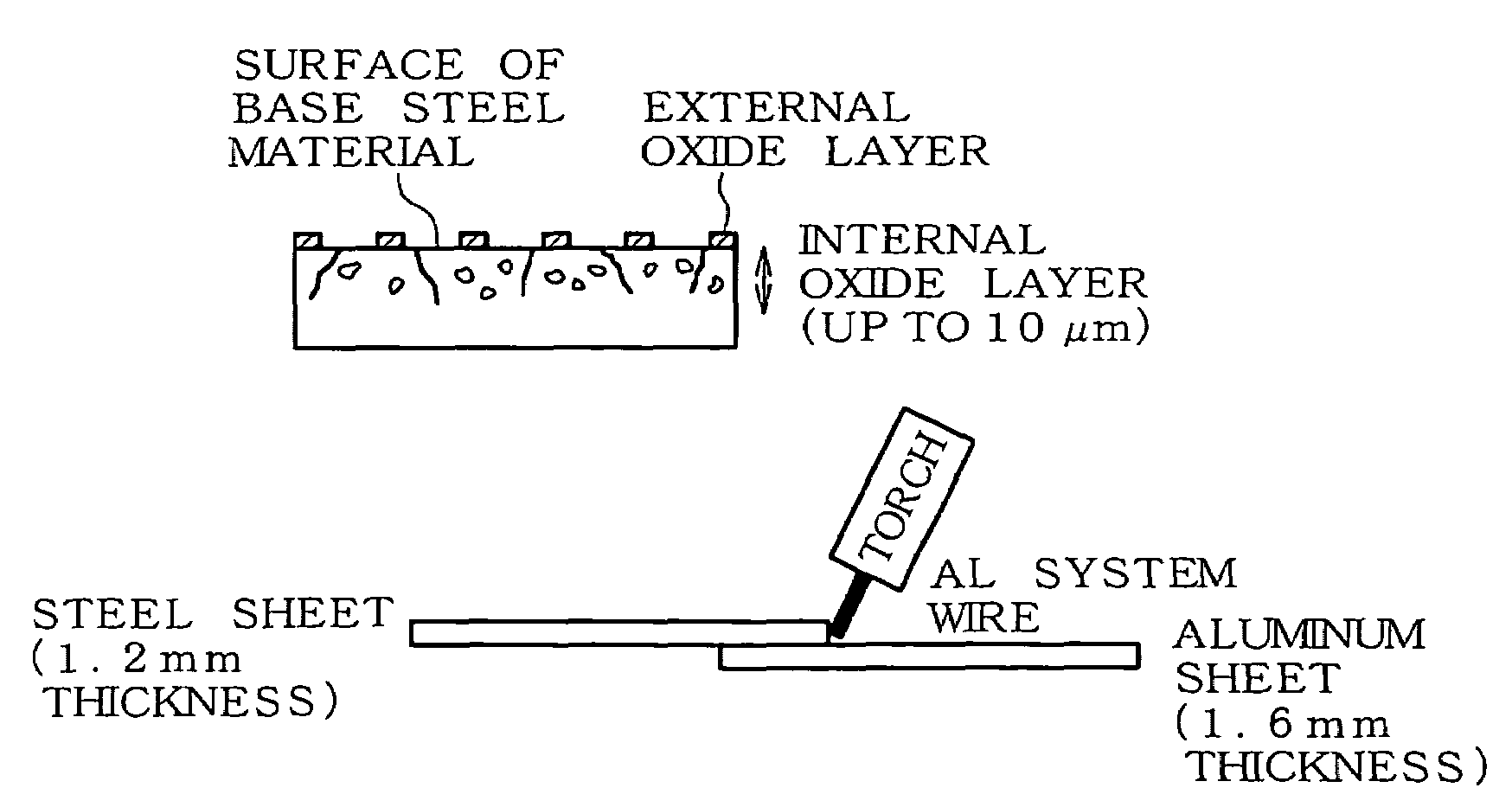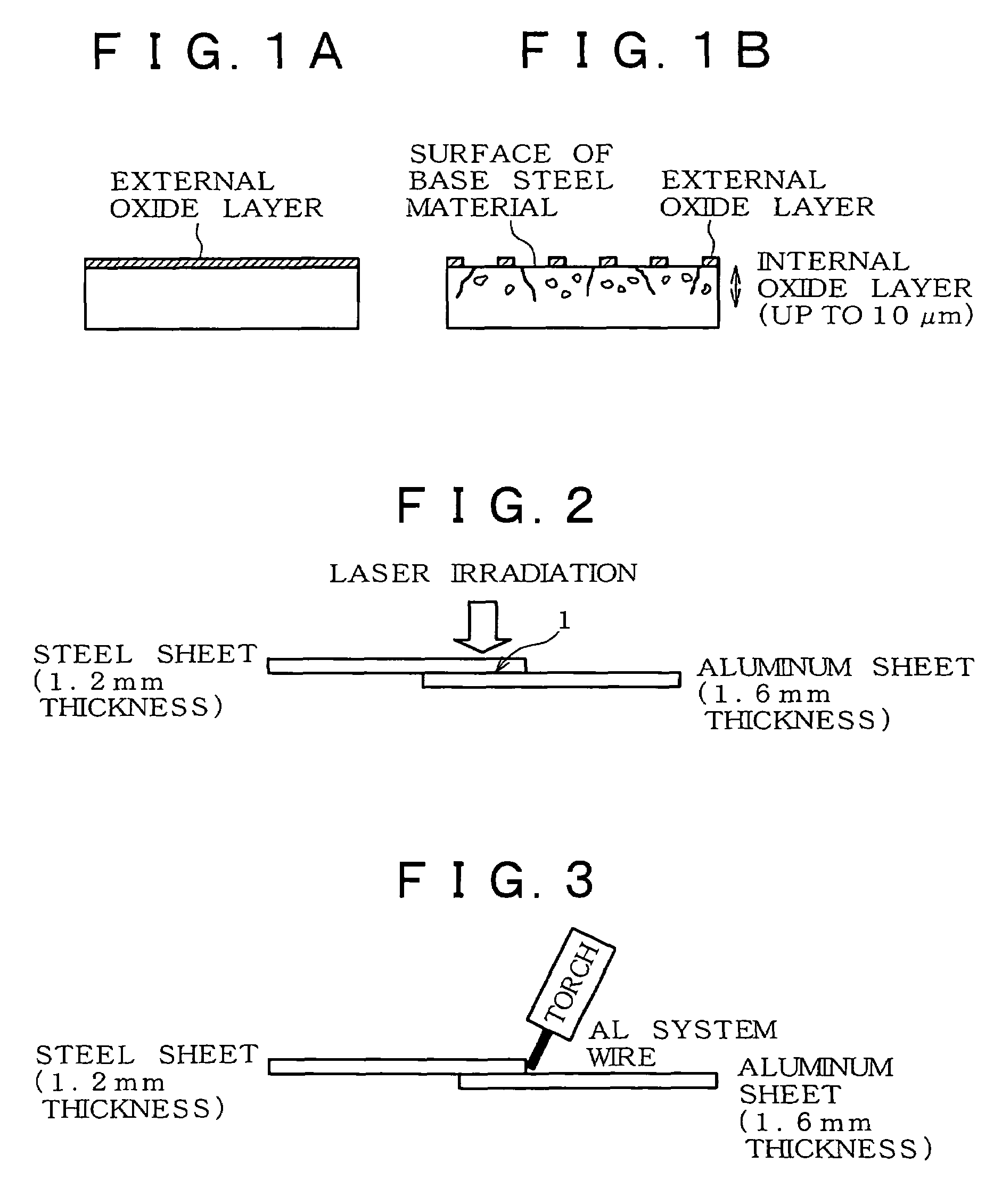Steel sheet for dissimilar materials weldbonding to aluminum material and dissimilar materials bonded body
a technology of dissimilar materials and aluminum, which is applied in the direction of metal-layer products, metal-working equipment, metal-layer coating processes, etc., can solve the problems of insufficient reliability in the quality of bonded joints, increased welding costs, and complicated operations, and achieves high bonding strength, high bonding strength and reliability, and the effect of minimal thickness
- Summary
- Abstract
- Description
- Claims
- Application Information
AI Technical Summary
Benefits of technology
Problems solved by technology
Method used
Image
Examples
example 1
[0102]Steel sheets produced by melting, refining and then rolling to the thickness of 1.2 mm the steels having component compositions shown in Table 1 were once pickled and the existing surface oxidation layers were removed. Thereafter, steel sheets having different oxidation structures were produced by variously changing the oxygen partial pressure (dew point) in an annealing atmosphere under the conditions A, B, C, D, and E shown in Table 2.
[0103]The oxidation structures of the steel sheets after annealed are shown in Tables 4 to 7. Here, each oxidation structure at the bonded-equivalent part of each steel sheet was measured by the following relevant measuring method.
(Range of External Oxide Formation)
[0104]External oxide was identified by producing a cross-sectional specimen with a focused ion beam processor (FB-2000A made by Hitachi, Ltd.), analyzing an interface between a base steel material and an external oxide layer nearly in the horizontal direction on a section...
example 2
[0134]In the same way as Example 1, steel sheets 1.2 mm in thickness having component compositions shown in Table 1 were once pickled and the existing surface oxidation layers were removed. Thereafter, steel sheets having different oxidation structures were produced by variously changing the oxygen partial pressures (dew points) in the annealing atmosphere under the conditions shown in Table 2.
[0135]The steel sheets and the same aluminum sheets 1.6 mm in thickness as used in Example 1 were cut into the size of 100 mm×300 mm. An end part of each of the steel sheets was overlapped with an end part of each of the aluminum sheets (overlap width was 30 mm), the overlapped end parts were laser-welded under the arrangement shown in FIG. 2, and thus a dissimilar materials bonded body was produced.
[0136]The principal conditions of the laser welding are shown in Tables 8 and 9. With regard to other laser welding conditions, a YAG laser welder having the maximum output of 4.0 kW was used and t...
example 3
[0148]In the same way as Example 1, steel sheets 1.2 mm in thickness having component compositions shown in Table 1 were once pickled and the existing surface oxidation layers were removed. Thereafter, steel sheets having different oxidation structures were produced by variously changing the oxygen partial pressures (dew points) in the annealing atmosphere under the conditions shown in Table 2.
[0149]The steel sheets and the same aluminum sheets 1.6 mm in thickness as used in Example 1 were cut into the size of 100 mm×300 mm. An end part of each of the steel sheets was overlapped with an end part of each of the aluminum sheets as shown in FIG. 3 and subjected to MIG brazing to form a lap fillet welded joint (overlap width was 15 mm). The MIG brazing was carried out with an AC power supply.
[0150]The wires used were Al type wires as shown in Tables 10 and 11 and those were A4043-WY, A4047-WY, A5356-WY, and A5183-WY stipulated in JIS, for example.
[0151]The thickness and the range of the...
PUM
| Property | Measurement | Unit |
|---|---|---|
| length | aaaaa | aaaaa |
| depth | aaaaa | aaaaa |
| area percentage | aaaaa | aaaaa |
Abstract
Description
Claims
Application Information
 Login to View More
Login to View More - R&D
- Intellectual Property
- Life Sciences
- Materials
- Tech Scout
- Unparalleled Data Quality
- Higher Quality Content
- 60% Fewer Hallucinations
Browse by: Latest US Patents, China's latest patents, Technical Efficacy Thesaurus, Application Domain, Technology Topic, Popular Technical Reports.
© 2025 PatSnap. All rights reserved.Legal|Privacy policy|Modern Slavery Act Transparency Statement|Sitemap|About US| Contact US: help@patsnap.com


